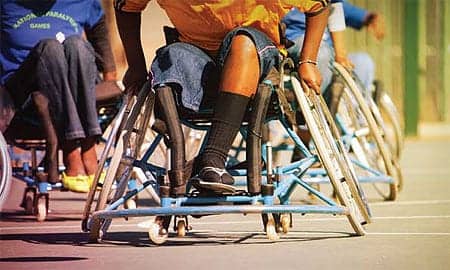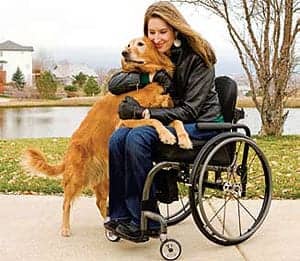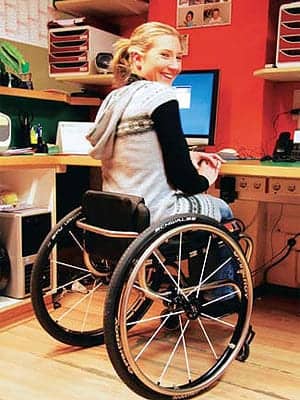Photography courtesy of Tilite and Sunrise Medical

Over the last 5 years, ultralightweight rigid frame manual wheelchairs have evolved into highly customizable mobility devices that can truly improve the quality of life of the end user. When properly prescribed and configured, today’s ultralightweight rigid frames can provide an end user with an efficient means of functional mobility, increased independence, and a reduced risk for developing overuse syndromes associated with long-term wheelchair use. When improperly prescribed, the exact opposite can be true.
When it comes to obtaining accurate specifications for ultralight rigid frame wheelchairs, however, there is ample evidence to suggest rehabilitation therapists could be doing a much better job.
Perhaps the best indicator of our effectiveness comes from the collective voice of the end users. While many may be unwilling to participate in formal research about the wheelchairs they receive, they will openly express their opinions to one another online. One of the largest online SCI forums is CareCure Community (sci.rutgers.edu). In 2006, one of its members polled other users about the fit of their first chairs. More than a third of the total respondents replied that their first chairs had the “wrong measurements.”1
While “Internet-based practice” is no substitute for evidence-based practice, these results are compelling. Even if formal research were to reveal that the actual percentage was only half of that value, the number of improperly fitted ultralight wheelchairs inflicted on end users by those responsible for prescribing them is unacceptable.
Many of the mistakes that therapists make when prescribing ultralight rigid frames can be attributed to a belief that anthropometric measurements can be translated into product specifications, failing to consider clinical findings in an appropriate context, and an excessive reliance on others for product information. Most importantly, many fail to involve the end user throughout the decision-making process.
RULE ONE: DISREGARD THE RULES
Therapists who are just learning to prescribe an ultralight rigid frame should set aside much of the didactic information they may have received during their formal education. Clinical mat evaluations are necessary to assess posture, sitting balance, joint range of motion, and flexibility. However, they should never be used to determine specific rigid frame dimensions.
Measurements obtained with the subject’s hips/knees in 90° of flexion and their feet flat on the floor cannot be transformed into accurate rigid frame specifications using any of the so-called “two-inch rules”:
Seat Depth = Upper Leg Length – 2 inches
Seat Width = Pelvic Breadth + 2 inches
Seat Height = Lower Leg Length – Cushion Thickness + 2 inches
In the best case scenario, the therapist has succeeded in obtaining accurate measurements for the fabled “90°/90°/90°” sitting posture. Yet, it was in this very publication that Jean Minkel, PT, told us that we need to let go of that rule: “The goal of adaptive seating, however, needs to be more than positioning the pelvis in neutral and straightening the trunk to achieve 90°/90°/90° at the hips, knees, and ankles. Rather, the goal should be to provide the external support, at the angles needed by an individual, to achieve an upright, stable, and functional seated position.”2
In the case of the ultralight rigid frame, linear measurements taken at the edge of a mat are unlikely to result in a chair that fits correctly, nor will they ensure a functional seated posture. Most of the support needed to attain this posture should be the result of the seamless integration of a relatively minimalist seating system with the various dimensions, curves, and angles that have been designed into the wheelchair’s custom frame. Problems are identified on the mat, but solved by the chair.

A wheelchair should not only meet a therapist’s pressure management, positioning, and propulsion objectives, but should enable the user to conduct their day-to-day activities.
RULE TWO: EMPLOY A USABILITY FRAMEWORK
Therapists often fail to consider their clinical findings in an appropriate context. For the ultralight rigid frame user, their wheelchair will be more than just a means of getting from point A to point B. It will play a central role in how easily they can do almost everything else for years to come. A wheelchair that meets the pressure management, positioning, and propulsion objectives of the therapist will not provide any of the associated benefits to the end user if they do not use it because it fails to meet their needs. The interaction between a user and product to accomplish a task in a given environment describes the concept of usability. Whenever something about a wheelchair prevents a person from doing something they feel is essential to their day-to-day function, abandonment becomes a significant possibility. To reduce the chances of this, the process of obtaining specifications should take place within the broader context of a usability framework.
Optimal usability is most likely to be achieved when the most appropriate model is selected in the best configuration to meet as many needs of the end user as possible in their expected environment(s). The goal of the specification process should be to attain an “optimal configuration” of a product for that individual. It involves striking a balance between four “Fs”—form, fit, function, and footprint.
There is no perfect ultralight rigid frame wheelchair that will meet every need of a specific end user. As a result, it is not possible to determine the optimal configuration without having the meaningful participation of the end user. Their input not only helps to establish problems, priorities, and preferences, it helps ensure that the person who ultimately has to live with the wheelchair is aware of any compromises/concessions necessary to arrive at their optimal configuration. When reimbursement issues limit user choice, they should be aware of this. Doing so may empower them to advocate for themselves or consider alternative resources to obtain a specific model or option.
RULE THREE: USE A “RELATIVITY” APPROACH
I have found I am most confident in my specifications when I am able to apply the “Wheelchair Theory of Relativity.” It is actually a relatively straightforward, common sense approach. Once an individual is identified as an appropriate candidate for an ultralight rigid frame, equipment trials should be arranged using loaner or manufacturer’s demo wheelchairs. Wheelchairs that are used in the equipment trial should have undergone sufficient reconfiguration so that both the therapist and the end user feel reasonably confident that a particular model, when ordered in a given configuration, will meet mutually agreed on needs.
Once this is accomplished, applying the “relativity” approach to the measuring process is simply a matter of determining what aspects of the trial wheelchair would need to be changed “relative” to known specifications about that equipment to arrive at the optimal configuration. Many manufacturers have serial number look-up tools online, which can be valuable when identifying specifications for a particular chair. If the trial wheelchair has been configured to be reasonably close to what the person needs, the therapist should be able to visualize the optimal configuration for a proposed wheelchair.
To successfully apply the relativity approach, it is essential for therapists to take into account how posture, positioning, and pressure management objectives will be addressed. Adjustable ultralight wheelchairs provide some degree of adjustability, but that range of adjustment may be limited. Custom backs almost always require an additional inch of seat depth. A person will sit higher on a cushion with a firm foam base with contours to offload pressure from bony prominences than they will on an air flotation cushion designed to immerse them into 2-inch-high air cells. Unless custom backs and cushion type are accounted for at the time that specifications are obtained, it may not be possible to compensate for any oversights if the range of adjustability has been exceeded. The result can be a poorly fitting wheelchair, which could be difficult to self-propel due to suboptimal access to the push rims.
RULE FOUR: INTEGRATE THE PREVIOUS RULES WITH KNOWLEDGE OF PRODUCT

Ultimately, the end user’s input will determine the optimal ultralightweight wheelchair configuration that will suit their personal and environmental needs.
While different models may at first appear to be very similar, specific characteristics and features inherent to each manufacturer’s design can differentiate one product from another. Those therapists who acquire a “hands-on” familiarity with products will be better able to differentiate these features than those who rely on others. In most instances, the best model/features for an individual will emerge as these differences are considered in the broader context of the person’s needs and preferences.
Ideally, specifications should be obtained using a manufacturer’s demo of the same model used in the trial. In reality, this is frequently not the case. Whenever a suitable demo is not available, the accuracy of specifications will largely depend on one’s knowledge of competitive models and the ability to “translate” specifications between models.
RULE FIVE: USE THE ORDER FORM AS STRUCTURE
It is tempting for the therapists and suppliers to silently fill out the order forms once there has been some consensus about the specific model. While this may seem to be more efficient than having to take the time to explain a myriad of confusing options to the end user, many selections on the order form affect other selections. If the goal is to prescribe the most appropriate model in an optimal configuration, discussing the pros and cons of each option becomes essential to the process. While at times tedious, order forms can be a useful tool for structuring such discussions. A final review at the end of the evaluation also helps ensure that nothing was omitted, there are no misunderstandings, and everything is accurate.
SUMMARY
It is hoped that this information will encourage rehabilitation therapists learning to prescribe ultralight rigid frame to set aside some of the “rules” they have been taught in school and take a more practical approach that emphasizes a need to understand the person, their problems, and priorities, then match those with the most appropriate product for their needs. Experienced rigid frame users are often given credit for “knowing exactly what they want” when it is time for a new wheelchair. In reality, most base their specifications on an existing wheelchair using a “relativity” approach. They determine their optimal configuration based on what has worked and what has not worked in the past. They frequently go online for product information and advice from other end users. The CareCure poll referenced early in this article is open indefinitely. If we learn to follow their lead, it is hoped that fewer first chairs will fit inappropriately in the future.
Steve Mitchell, OTR/L, ATP, is an occupational therapist who provides seating/wheeled mobility and assistive technology intervention to veterans at the Cleveland VA’s Regional SCI Center. He is also an ultralight rigid frame wheelchair end user who regularly contributes to the equipment forum using the screen name SCI_OTR on CareCure Community (http://sci.rutgers.edu). He can be contacted at .
REFERENCES
- CareCure Community. Did your first chair suck? sci.rutgers.edu/forum/showthread.php?t=66830. Updated September 20, 2010. Accessed December 12, 2010.
- Minkel JL. Sitting outside of the box. Rehab Management. 2001:14(8). Available at: www.rehabpub.com/ltrehab/112001/2.asp. Accessed November 18, 2010.




